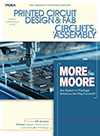News
News
Precision MicroOffers ‘Quiet Corners’ to Improve Shielding Attenuation
Published: 27 October 2005
by Staff
Profiled and folded shielding cans offer many benefits, including bespoke design, exceptional co-planarity, low tooling costs etc., but one drawbacks is the corner seam, which can act as an emitter antenna if it is not folded and mounted with care. This corner seam can be soldered for complete integrity in high frequency applications but much of the time, the need is simply to reduce the maximum linear dimension.
A new finger joint arrangement on the corner seam allows two adjacent walls to interlock along the corner seam.
The Quiet Corner design reportedly improves noise attenuation and the mechanical stability of the shielding can.
Press Releases
- ASMPT and IBM Deepen Collaboration to Advance Bonding Methods for Chiplet Packages for AI
- Murray Percival Company Expands Product Line with Representation of BIMOS ESD Seating in the Midwest
- Selectronic Assembly Welcomes Eliud Herrera as Production Manager
- SP Manufacturing Holds Milestone Anniversary Celebration







